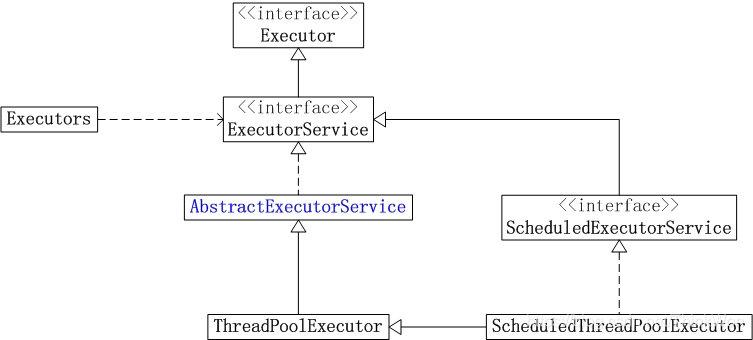
上图是线程池的架构图。Java里面线程池的顶级接口是Executor,Executor并不是一个线程
池,而只是一个执行线程的工具。真正的线程池接口是ExecutorService。
比较重要的几个类:
| 类/接口 | 描述 |
|---|---|
| ExecutorService | 真正的线程池接口 |
| ScheduledExecutorService | 能和Timer/TimerTask类似,解决那些需要任务重复执行的问题 |
| ThreadPoolExecutor | ExecutorService的默认实现 |
| ScheduledThreadPoolExecutor | 继承ThreadPoolExecutor的ScheduledExecutorService接口实现,周期性任务调度的类实现 |
要配置一个线程池是比较复杂的,尤其是对于线程池的原理不是很清楚的情况下,很有可能配置的线程池不是较优的,因此在Executors类里面提供了一些静态工厂,生成一些常用的线程池。
Java通过Executors工厂类提供四种线程池,分别为:
我们先创建一个统一的线程任务,方便测试四种线程池
public class MyRunnable implements Runnable {
@Override
public void run() {
System.out.println(Thread.currentThread().getName() + " is running...");
}
}public class SingleThreadExecutorTest {
public static void main(String[] args) {
ExecutorService executorService = Executors.newSingleThreadExecutor();
MyRunnable myRunnable = new MyRunnable();
for (int i = 0; i < 5; i++) {
executorService.execute(myRunnable);
}
System.out.println("线程任务开始执行");
executorService.shutdown();
}
}输出结果
线程任务开始执行
pool-1-thread-1 is running...
pool-1-thread-1 is running...
pool-1-thread-1 is running...
pool-1-thread-1 is running...
pool-1-thread-1 is running...底层实现
/**
* 核心线程池大小=1
* 最大线程池大小为1
* 线程过期时间为0ms
* LinkedBlockingQueue作为工作队列
*/
public static ExecutorService newSingleThreadExecutor() {
return new FinalizableDelegatedExecutorService
(new ThreadPoolExecutor(1, 1,
0L, TimeUnit.MILLISECONDS,
new LinkedBlockingQueue<Runnable>()));
}从参数可以看出来,SingleThreadExecutor 相当于特殊的 FixedThreadPool,它的执行流程如下:
SingleThreadExecutor 用于串行执行任务的场景,每个任务必须按顺序执行,不需要并发执行。
public class FixedThreadPoolTest {
public static void main(String[] args) {
ExecutorService executorService = Executors.newFixedThreadPool(2);
MyRunnable myRunnable = new MyRunnable();
for (int i = 0; i < 5; i++) {
executorService.execute(myRunnable);
}
System.out.println("线程任务开始执行");
executorService.shutdown();
}
}输出结果
线程任务开始执行
pool-1-thread-1 is running...
pool-1-thread-1 is running...
pool-1-thread-2 is running...
pool-1-thread-1 is running...
pool-1-thread-2 is running...底层实现
/**
* 核心线程池大小=传入参数
* 最大线程池大小为传入参数
* 线程过期时间为0ms
* LinkedBlockingQueue作为工作队列
*/
public static ExecutorService newFixedThreadPool(int nThreads) {
return new ThreadPoolExecutor(nThreads, nThreads,
0L, TimeUnit.MILLISECONDS,
new LinkedBlockingQueue<Runnable>());
}可以看到,FixedThreadPool 的核心线程数和最大线程数都是指定值,也就是说当线程池中的线程数超过核心线程数后,任务都会被放到阻塞队列中。
此外 keepAliveTime 为 0,也就是多余的空余线程会被立即终止(由于这里没有多余线程,这个参数也没什么意义了)。
而这里选用的阻塞队列是 LinkedBlockingQueue,使用的是默认容量 Integer.MAX_VALUE,相当于没有上限。
因此这个线程池执行任务的流程如下:
FixedThreadPool 用于负载比较重的服务器,为了资源的合理利用,需要限制当前线程数量。
public class CachedThreadPoolTest {
public static void main(String[] args) {
ExecutorService executorService = Executors.newCachedThreadPool();
MyRunnable myRunnable = new MyRunnable();
for (int i = 0; i < 5; i++) {
executorService.execute(myRunnable);
}
System.out.println("线程任务开始执行");
executorService.shutdown();
}
}输出结果
线程任务开始执行
pool-1-thread-1 is running...
pool-1-thread-4 is running...
pool-1-thread-2 is running...
pool-1-thread-5 is running...
pool-1-thread-3 is running...底层实现
/**
* 核心线程池大小=0
* 最大线程池大小为Integer.MAX_VALUE
* 线程过期时间为60s
* 使用SynchronousQueue作为工作队列
*/
public static ExecutorService newCachedThreadPool() {
return new ThreadPoolExecutor(0, Integer.MAX_VALUE,
60L, TimeUnit.SECONDS,
new SynchronousQueue<Runnable>());
}可以看到,CachedThreadPool 没有核心线程,非核心线程数无上限,也就是全部使用外包,但是每个外包空闲的时间只有 60 秒,超过后就会被回收。
CachedThreadPool 使用的队列是 SynchronousQueue,这个队列的作用就是传递任务,并不会保存。
因此当提交任务的速度大于处理任务的速度时,每次提交一个任务,就会创建一个线程。极端情况下会创建过多的线程,耗尽 CPU 和内存资源。
它的执行流程如下:
CachedThreadPool 用于并发执行大量短期的小任务,或者是负载较轻的服务器。
public class ScheduledThreadPoolTest {
public static void main(String[] args) {
ScheduledExecutorService scheduledExecutorService = Executors.newScheduledThreadPool(3);
MyRunnable myRunnable = new MyRunnable();
for (int i = 0; i < 5; i++) {
// 参数1:目标对象,参数2:隔多长时间开始执行线程,参数3:执行周期,参数4:时间单位
scheduledExecutorService.scheduleAtFixedRate(myRunnable, 1, 2, TimeUnit.SECONDS);
}
System.out.println("线程任务开始执行");
}
}输出结果
线程任务开始执行
// 打印【线程任务开始执行】后1秒输出
pool-1-thread-1 is running...
pool-1-thread-2 is running...
pool-1-thread-1 is running...
pool-1-thread-3 is running...
pool-1-thread-2 is running...
// 2秒后输出
pool-1-thread-1 is running...
pool-1-thread-3 is running...
pool-1-thread-2 is running...
pool-1-thread-1 is running...
pool-1-thread-3 is running...底层实现
/**
* 核心线程池大小=传入参数
* 最大线程池大小为Integer.MAX_VALUE
* 线程过期时间为0ms
* DelayedWorkQueue作为工作队列
*/
public ScheduledThreadPoolExecutor(int corePoolSize) {
super(corePoolSize, Integer.MAX_VALUE, 0, NANOSECONDS,
new DelayedWorkQueue());
}ScheduledThreadPoolExecutor 的执行流程如下:
具体执行任务的步骤也比较复杂:
线程从 DelayQueue 中获取 time 大于等于当前时间的 ScheduledFutureTask
执行完后修改这个 task 的 time 为下次被执行的时间
然后再把这个 task 放回队列中
ScheduledThreadPoolExecutor 用于需要多个后台线程执行周期任务,同时需要限制线程数量的场景。
Executors 各个方法的弊端:
ThreaPoolExecutor
ExecutorService 提供了两种提交任务的方法:
void execute(Runnable command);execute() 的参数是一个 Runnable,也没有返回值。因此提交后无法判断该任务是否被线程池执行成功。
ExecutorService executor = Executors.newCachedThreadPool();
executor.execute(new Runnable() {
@Override
public void run() {
//do something
}
});<T> Future<T> submit(Callable<T> task);
<T> Future<T> submit(Runnable task, T result);
Future<?> submit(Runnable task);submit() 有三种重载,参数可以是 Callable 也可以是 Runnable。
同时它会返回一个 Funture 对象,通过它我们可以判断任务是否执行成功。
获得执行结果调用 Future.get() 方法,这个方法会阻塞当前线程直到任务完成。
提交一个 Callable 任务时,需要使用 FutureTask 包一层:
FutureTask futureTask = new FutureTask(new Callable<String>() { //创建 Callable 任务
@Override
public String call() throws Exception {
String result = "";
//do something
return result;
}
});
Future<?> submit = executor.submit(futureTask); //提交到线程池
try {
Object result = submit.get(); //获取结果
} catch (InterruptedException e) {
e.printStackTrace();
} catch (ExecutionException e) {
e.printStackTrace();
}原文:https://www.cnblogs.com/Chary/p/12633936.html